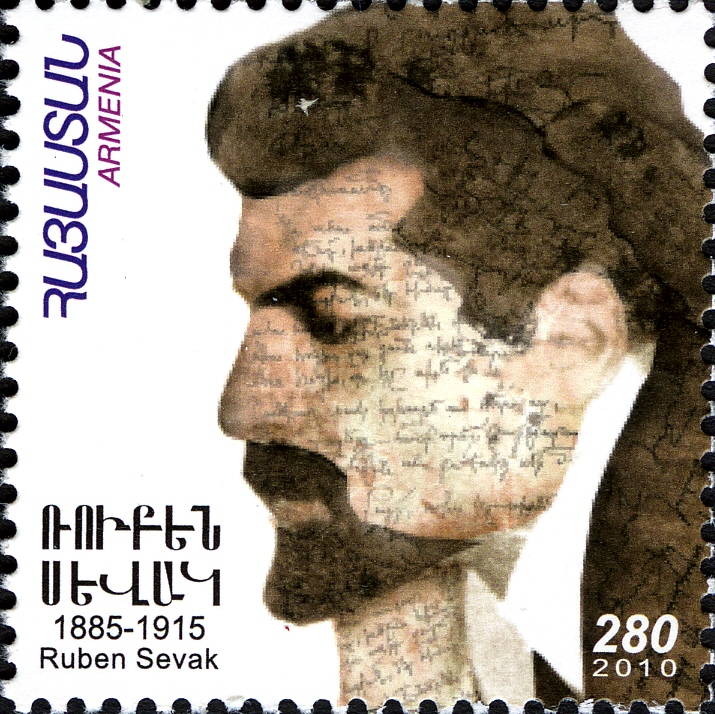Ruben Sevak on:
[Wikipedia]
[Google]
[Amazon]
Rupen Chilingiryan (Sevag) (Ռուբէն Յովհաննէսի Չիլինկիրեան (Սեւակ), February 28, 1886,
Der Dichter und seine Frau
Deutsch-Armenische Gesellschaft. ADK 139, p. 46-48 After graduating in 1911, he decided to go back to Constantinople in 1914 with his family. This decision would cost him his life. He was
Silivri
Silivri, formerly Selymbria (Greek: Σηλυμβρία), is a city and a district in Istanbul Province along the Sea of Marmara in Turkey, outside the urban core of Istanbul, containing many holiday and weekend homes for residents of the city. The ...
, Ottoman Empire
The Ottoman Empire, * ; is an archaic version. The definite article forms and were synonymous * and el, Оθωμανική Αυτοκρατορία, Othōmanikē Avtokratoria, label=none * info page on book at Martin Luther University) ...
– August 26, 1915, Çankırı
Çankırı, historically known as Gangra (Greek: Γάγγρα), is the capital city of Çankırı Province, in Turkey, about northeast of Ankara. It is situated about 800 m (2500 ft) above sea level.
History
Çankırı was known in ...
, Ottoman Empire) was an Armenian
Armenian may refer to:
* Something of, from, or related to Armenia, a country in the South Caucasus region of Eurasia
* Armenians, the national people of Armenia, or people of Armenian descent
** Armenian Diaspora, Armenian communities across the ...
poet
A poet is a person who studies and creates poetry. Poets may describe themselves as such or be described as such by others. A poet may simply be the creator ( thinker, songwriter, writer, or author) who creates (composes) poems ( oral or wr ...
, prose-writer, and doctor.Gregoire Balakian: ''Le Golgotha arménien'', Le cercle d'écrits caucasiens, La Ferté-Sous-Jouarre 2002 (vol. 1) pp. 442 He was sent to a concentration camp along with Siamanto
Atom Yarchanian ( hy, Ատոմ Եարճանեան), better known by his pen name Siamanto (Սիամանթօ) (15 August 1878 – August 1915), was an influential Armenian writer, poet and national figure from the late 19th century and early 20 ...
and Daniel Varoujan during the Armenian Genocide
The Armenian genocide was the systematic destruction of the Armenians in the Ottoman Empire, Armenian people and identity in the Ottoman Empire during World War I. Spearheaded by the ruling Committee of Union and Progress (CUP), it was ...
.
Biography
Rupen Sevag received his elementary education in his birthplace at the Askanazian school. He then moved toConstantinople
la, Constantinopolis ota, قسطنطينيه
, alternate_name = Byzantion (earlier Greek name), Nova Roma ("New Rome"), Miklagard/Miklagarth ( Old Norse), Tsargrad ( Slavic), Qustantiniya (Arabic), Basileuousa ("Queen of Cities"), Megalopolis ( ...
(now Istanbul
Istanbul ( , ; tr, İstanbul ), formerly known as Constantinople ( grc-gre, Κωνσταντινούπολις; la, Constantinopolis), is the List of largest cities and towns in Turkey, largest city in Turkey, serving as the country's economic, ...
) and studied at the prestigious Berberian School The Berberian School or ''Berberian Varjaran'' ( hy, Պէրպէրեան վարժարան) was an Armenian school. It was founded in Scutari, Constantinople in 1876 by Reteos Berberian. It was renowned for its high standards and it prepared students ...
. He graduated in 1905 and went to Lausanne
Lausanne ( , , , ) ; it, Losanna; rm, Losanna. is the capital and largest city of the Swiss French speaking canton of Vaud. It is a hilly city situated on the shores of Lake Geneva, about halfway between the Jura Mountains and the Alps, and fac ...
, Switzerland, to pursue studies at the medical school. He met there his future wife, Helene Apell.Deutsch-Armenische Gesellschaft. ADK 139, p. 46-48 After graduating in 1911, he decided to go back to Constantinople in 1914 with his family. This decision would cost him his life. He was
arrested
An arrest is the act of apprehending and taking a person into custody (legal protection or control), usually because the person has been suspected of or observed committing a crime. After being taken into custody, the person can be questi ...
on at the onset of the Armenian genocide
The Armenian genocide was the systematic destruction of the Armenians in the Ottoman Empire, Armenian people and identity in the Ottoman Empire during World War I. Spearheaded by the ruling Committee of Union and Progress (CUP), it was ...
on April 24, 1915, and killed on August 26, 1915.

Creative poet
Sevag's first poem was printed in 1905. Sevag is mostly known as a lyric poet. He also composed many love songs, highly acclaimed for their feeling and depth. His poetry was characterized by freshness and precision of language, and noted for its varying meter and its musicality. His poetry captures the history and essence of Western Armenian literature while creating a totally new genre.References
1885 births 1915 deaths People from Silivri Armenians from the Ottoman Empire 20th-century Armenian poets Armenian physicians People who died in the Armenian genocide Armenian medical writers Armenian male poets 19th-century Armenian writers Lyric poets 19th-century male writers Berberian School alumni 20th-century physicians Poets from the Ottoman Empire {{Armenia-genocide-stub